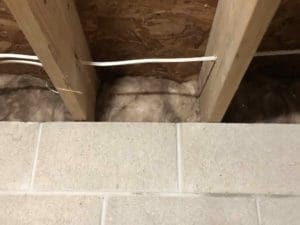One of the most often neglected parts of insulation are the rim joists — that cavity in basements where the floor meets the concrete wall.

Fiberglass batt insulation can be a great way to insulate, but not so great if the goal is to keep cold air out.
There are a couple options for insulating rim joists. Traditionally, homeowners pack them with batt insulation. Rock wool or fiberglass are the most common types of insulation used for these areas but they only address part of the challenge.
There are a few factors that make these areas difficult stop drafts. When a home is built, the builder brings together masons to build the cement or block basement walls. A framer uses wood to build the floor joists, which rest on the masonry walls, to erect the home. Those two products do work well for their purposes, but one is organic (wood) and one is inorganic (cement) and both of them have varying expansion and contraction rates.

Infrared camera photos show cold air leaking in around fiberglass batts from the same cavity in the photo above
Fortunately insulation batts can flex that small amount that a house does, but sometimes there are air leaks that cannot be seen to the human eye. Air leaks cannot be stopped by insulation alone.
That’s where closed cell foam comes in. Providing an impressive R-7 per inch on average, closed cell foam can effectively seal off air that is causing the loss of energy, and of comfort, in your house.
Closed cell foam is a combination of two chemicals, which when mixed, create foam. When the foam comes out of the mixing nozzle, it sticks to whatever surface it is sprayed upon. Since the foam retains a certain amount of flexibility, it binds to both the inorganic (cement) and organic (wood) surfaces.
This makes closed cell foam a great product for air sealing.
But before any DIY enthusiasts get excited and run out to pick up a few canisters of chemicals made by the same company that brought us Agent Orange, keep in mind that when the foam comes out of the end of the mixing nozzle, it is effectively plastic. Inhaling it without the proper type of respirator can be fatal. Laying the foam onto surfaces too thick can result in combustion or even fire. And if killing you or your family or burning down your house aren’t enough, you’re never going to get it off of your clothes. Maybe you don’t want to wear your favorite pair of Calvins.

